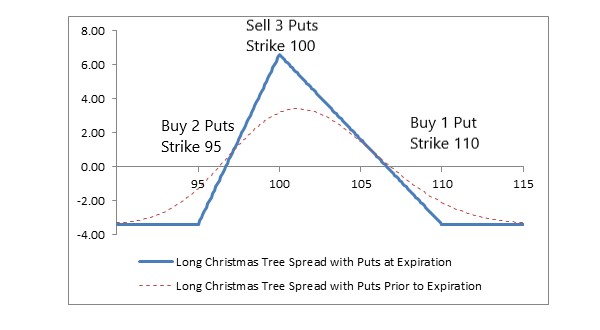
In the example above,
- Buy 1 Put strike 110
- Sell 3 Puts strike 100
- Buy 2 Puts strike 95
All puts have the same expiration date, and the four strike prices are equidistant.
The position is established for a net debit, and both the potential profit and maximum risk are limited.
Strike prices are equidistant, and all options have the same expiration month.
Risk is limited to the net debit paid: after the trade is paid for, no additional margin is required.
Price expectations
While a traditional butterfly with puts is often used as a neutral strategy, this strategy is usually run with a slightly bearish or bullish directional bias.
The forecast, therefore, can either be “neutral”, “modestly bullish” or “modestly bearish” depending on the relationship of the stock price to the strike price of the short puts when the position is established:
- If the stock price is at or near the strike price of the short puts (100 in our example) when the position is established, then the forecast must be for unchanged, or neutral, price action.
- If the stock price is below the strike price of the short puts when the position is established, for example at 95, then the forecast must be for the stock price to rise to that strike price at expiration (modestly bullish).
- If the stock price is above the strike price of the short puts when the position is established, for example at 110, then the forecast must be for the stock price to fall to that strike price at expiration (modestly bearish).
This may be an affordable alternative to a long call or put when calls or puts are prohibitively expensive because of high implied volatility.
Volatility expectations
If the stock is at or near strike 100, you want volatility to decrease.
Your main concern is the three options you sold, and a decrease in implied volatility will cause those near-the-money options to decrease in value, thereby increasing the overall value of the butterfly.
In addition, you want the stock price to remain stable around strike 100, and a decrease in implied volatility suggests that may be the case.
If the stock price is approaching the strike price 95 or 110, in general you want volatility to increase. An increase in volatility will increase the value of the options you own at 95 or 110 strike, while having less effect on the short options at strike 100.
